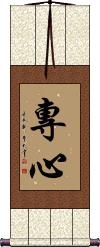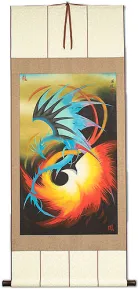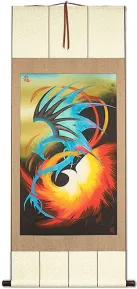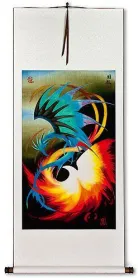Many custom options...
And formats...

Not what you want?
Try other similar-meaning words, fewer words, or just one word.
Feel free to email me with your request. If it's easy, I'll translate it for free and add it to this database of calligraphy for you.
My Purpose in Chinese / Japanese...
Buy a My Purpose calligraphy wall scroll here!
Devotion / Dedication / Attentive / Focused
專心 makes a word that means “paying attention with your heart.”
It's often translated as “dedication,” as in “be absorbed in” or “concentrate one's efforts.” It's also used to mean “with the single mind,” “whole-heartedly,” “paying attention,” “undivided attention,” “concentration (-ed),” “engrossed,” “devotionally (listening/watching),” and/or “attentive.”
The first character means “for a particular person, occasion, or purpose,” “focused on one single thing,” “concentrated,” and sometimes, “special.”
The second character means “heart” or “mind” by itself.
My favorite translation, which comes from the Oxford Advanced Chinese/English Dictionary, is, “wholehearted devotion.”
If it seems like the meaning of this word is quite open, you are correct. The context in which the word is used matters a lot. It can mean different things depending on how you use it. This makes it kind of nice as you can decide what this means to you (within some limits). This is always positive in meaning, so even if a Chinese person reads it differently than you, it will still have a good meaning.
![]() In Japanese, they tend to use a variation of the second character which has one less stroke. If you want your calligraphy written this Japanese form, please click on the Kanji shown to the right instead of the button above. Note: Japanese and Chinese people will recognize either form.
In Japanese, they tend to use a variation of the second character which has one less stroke. If you want your calligraphy written this Japanese form, please click on the Kanji shown to the right instead of the button above. Note: Japanese and Chinese people will recognize either form.
This in-stock artwork might be what you are looking for, and ships right away...
Gallery Price: $144.00
Your Price: $79.88
Not the results for my purpose that you were looking for?
Below are some entries from our dictionary that may match your my purpose search...
| Characters If shown, 2nd row is Simp. Chinese |
Pronunciation Romanization |
Simple Dictionary Definition |
義 义 see styles |
yì yi4 i gi ぎ |
More info & calligraphy: Justice / Rectitude / Right Decision(noun - becomes adjective with の) (1) morality; righteousness; justice; honour (honor); (noun - becomes adjective with の) (2) meaning; (noun - becomes adjective with の) (3) {Buddh} teachings; doctrine; (n,n-pref) (4) nonconsanguineous relationship (i.e. of in-laws); (n,n-pref) (5) prosthesis; (surname) Yoshimura The right, proper, righteous; loyal; public-spirited, public; meaning, significance. It is used for the Skt. artha, object, purpose, meaning, etc.; also for abhidheya. |
鏡 镜 see styles |
jìng jing4 ching kagami かがみ |
More info & calligraphy: Mirror(1) mirror; looking-glass; (2) barrel head; (3) {finc} page added at the beginning of a document mentioning its purpose, date, author, etc.; (4) (abbreviation) (See 鏡餅・かがみもち) mirror-shaped mochi; (female given name) Mira ādarśa. A mirror. |
地獄 地狱 see styles |
dì yù di4 yu4 ti yü jigoku じごく |
More info & calligraphy: Hell(1) {Buddh} hell realm; Naraka; (2) {Christn} Hell; (3) hell; misery; nightmare; inferno; (4) place where a volcano or hot springs constantly spew smoke or steam; (place-name) Jigoku naraka, 捺落迦 (or 那落迦) ; niraya 泥犂; explained by 不樂 joyless; 可厭 disgusting, hateful; 苦具, 苦器 means of suffering; if 地獄 earth-prison; 冥府 the shades, or departments of darkness. Earth-prison is generally intp. as hell or the hells; it may also be termed purgatory; one of the six gati or ways of transmigration. The hells are divided into three classes: I. Central, or radical, 根本地獄 consisting of (1) The eight hot hells. These were the original hells of primitive Buddhism, and are supposed to be located umder the southern continent Jambudvīpa 瞻部州, 500 yojanas below the surface. (a) 等活 or 更活 Saṃjīva, rebirth, where after many kinds of suffering a cold wind blows over the soul and returns it to this life as it was before, hence the name 等活. (b) 黑繩 Kaslasūtra, where the sufferer is bound with black chains and chopped or sawn asunder. (c) 線合; 衆合; 堆壓 Saṃghāta, where are multitudes of implements of torture, or the falling of mountains upon the sufferer. (d) 號呌; 呼呼; 叫喚 Raurava, hell of wailing. (e) 大呌; 大號呌; 大呼 Mahāraurava, hell of great wailing. (f) 炎熱; 燒炙 Tapana, hell of fames and burning. (g) 大熱; 大燒炙; 大炎熱 Pratāpana, hell of molten lead. (h) 無間; 河鼻旨; 阿惟越致; 阿毗至; 阿鼻; 阿毗 Avīci, unintermitted suffering, where sinners die and are reborn to suffer without interval. (2) The eight cold hells 八寒地獄. (a) 頞浮陀地獄 Arbuda, where the cold causes blisters. (b) 尼刺部陀 Nirarbuda, colder still causing the blisters to burst. (c) 頞哳吒; 阿吒吒 Atata, where this is the only possible sound from frozen lips. (d) 臛臛婆; 阿波波 Hahava or Apapa, where it is so cold that only this sound can be uttered. (e) 虎虎婆 Hāhādhara or Huhuva, where only this sound can be uttered. (f) 嗢鉢羅; 鬱鉢羅 (or 優鉢羅) Utpala, or 尼羅鳥 (or 漚) 鉢羅 Nīlotpala, where the skin is frozen like blue lotus buds. (g) 鉢特摩 Padma, where the skin is frozen and bursts open like red lotus buds. (h) 摩訶鉢特摩 Mahāpadma, ditto like great red lotus buds. Somewhat different names are also given. Cf. 倶舍論 8; 智度論 16; 涅槃經 11. II. The secondary hells are called 近邊地獄 adjacent hells or 十六遊增 each of its four sides, opening from each such door are four adjacent hells, in all sixteen; thus with the original eight there are 136. A list of eighteen hells is given in the 十八泥梨經. III. A third class is called the 孤地獄 (獨地獄) Lokāntarika, or isolated hells in mountains, deserts, below the earth and above it. Eitel says in regard to the eight hot hells that they range 'one beneath the other in tiers which begin at a depth of 11,900 yojanas and reach to a depth of 40,000 yojanas'. The cold hells are under 'the two Tchahavālas and range shaft-like one below the other, but so that this shaft is gradually widening to the fourth hell and then narrowing itself again so that the first and last hell have the shortest, those in the centre the longest diameter'. 'Every universe has the same number of hells, ' but 'the northern continent has no hell whatever, the two continents east and west of Meru have only small Lokāntarika hells... whilst all the other hells are required for the inhabitants of the southern continent '. It may be noted that the purpose of these hells is definitely punitive, as well as purgatorial. Yama is the judge and ruler, assisted by eighteen officers and a host of demons, who order or administer the various degrees of torture. 'His sister performs the same duties with regard to female criminals, ' and it may be mentioned that the Chinese have added the 血盆池 Lake of the bloody bath, or 'placenta tank' for women who die in childbirth. Release from the hells is in the power of the monks by tantric means. |
無心 无心 see styles |
wú xīn wu2 xin1 wu hsin mushin むしん |
More info & calligraphy: No Mind / Mushin(adj-na,adj-no,n) (1) innocence; (adj-na,n,adj-no) (2) insentient (i.e. plants, inanimate objects, etc.); (adj-na,n,adj-no) (3) {Buddh} (See 有心) free from obstructive thoughts; (vs,vt) (4) to pester someone (for cash, etc.) Mindless, without thought, will, or purpose; the real immaterial mind free from illusion; unconsciousness, or effortless action. |
目的 see styles |
mù dì mu4 di4 mu ti mokuteki もくてき |
More info & calligraphy: Purpose / Aim / Goalpurpose; goal; aim; objective; intention |
八正道 see styles |
bā zhèng dào ba1 zheng4 dao4 pa cheng tao hasshōdō はっしょうどう |
More info & calligraphy: The Noble Eightfold Path(Buddhist term) noble eightfold path (八正道分) Āryamārga. The eight right or correct ways, the "eightfold noble path" for the arhat to nirvāṇa; also styled 八道船, 八正門, 八由行, 八游行, 八聖道支, 八道行, 八直行, 八直道. The eight are: (1) 正見Samyag-dṛṣṭi, correct views in regard to the Four Axioms, and freedom from the common delusion. (2) 正思 Samyak-saṁkalpa, correct thought and purpose. (3) 正語 Samyag-vāc, correct speech, avoidance of false and idle talk. (4) 正業 Samyak-karmānta, correct deed, or conduct, getting rid of all improper action so as to dwell in purity. (5) 正命 Smnyag-ājīva, correct livelihood or occupation, avoiding the five immoral occupations. (6) 正精進 Samyag-vyāyāma, correct zeal, or energy in uninterrupted progress in the way of nirvāṇa. (7) 正念 Samyak-smṛti, correct remembrance, or memory, which retains the true and excludes the false. (8) 正定 Samyak-samadhi, correct meditation, absorption, or abstraction. The 正 means of course Buddhist orthodoxy, anything contrary to this being 邪 or heterodox, and wrong. |
同心協力 同心协力 see styles |
tóng xīn xié lì tong2 xin1 xie2 li4 t`ung hsin hsieh li tung hsin hsieh li |
More info & calligraphy: Working Together as One / Cooperation |
生き甲斐 see styles |
ikigai いきがい |
More info & calligraphy: Ikigai |
齊心協力 齐心协力 see styles |
qí xīn xié lì qi2 xin1 xie2 li4 ch`i hsin hsieh li chi hsin hsieh li |
More info & calligraphy: Work Together with One Heart |
使 see styles |
shǐ shi3 shih shi し |
to make; to cause; to enable; to use; to employ; to send; to instruct sb to do something; envoy; messenger (1) messenger; (2) (abbreviation) (See 検非違使) police and judicial chief (Heian and Kamakura periods); (3) {Buddh} (See 煩悩・2) klesha (polluting thoughts such as greed, hatred and delusion, which result in suffering); (female given name) Tsukasa To send; cause; a messenger; a pursuer, molester, lictor, disturber, troubler, intp. as 煩惱 kleśa, affliction, distress, worldly cares, vexations, and as consequent reincarnation. There are categories of 10, 16, 98, 112, and 128 such troublers, e. g. desire, hate, stupor, pride, doubt, erroneous views, etc., leading to painful results in future rebirths, for they are karma-messengers executing its purpose. Also 金剛童子 q. v. |
參 参 see styles |
shēn shen1 shen shin |
ginseng; one of the 28 constellations Reflect on, counsel, visit superior. An assembly a gathering for the purpose of meditation, preaching, worship. Read shen, the twenty-first constellation, α, β, γ, δ, ε, ζ, η, and k in Orion.; Worship on the four fives, i. e. the fifth, tenth, twentieth, and twenty-fifth days of the month; also ||上堂. |
堂 see styles |
táng tang2 t`ang tang dou / do どう |
(main) hall; large room for a specific purpose; CL:間|间[jian1]; relationship between cousins etc on the paternal side of a family; of the same clan; classifier for classes, lectures etc; classifier for sets of furniture (n,n-suf) (1) temple; shrine; chapel; (n,n-suf) (2) hall; (suffix) (3) (suffix used in company names, store names, etc.) company; (n,n-suf,n-pref) (4) (archaism) (See 表座敷) front room; (surname) Dōzaki prāsāda. A hall, temple, court. |
場 场 see styles |
chǎng chang3 ch`ang chang ba ば |
large place used for a specific purpose; stage; scene (of a play); classifier for sporting or recreational activities; classifier for number of exams (1) place; spot; space; (2) field; discipline; sphere; realm; (3) (See その場・1) occasion; situation; (4) scene (of a play, movie, etc.); (5) {stockm} session; (6) {cards} field; table; area in which cards are laid out; (7) {mahj} (See 東場,南場) round (east, south, etc.); (8) {physics} field; (9) {psych} field (in Gestalt psychology); (surname) Bazaki Area, arena, field, especially the bodhi-plot, or place of enlightenment, etc.; cf. 道場; 菩提場. |
塔 see styles |
tǎ ta3 t`a ta tou / to とう |
pagoda (abbr. of 塔婆[ta3po2], a loanword from Sanskrit stūpa); tower; pylon (CL:座[zuo4]); (loanword) (pastry) tart (n,n-suf) (1) tower; steeple; spire; (2) (abbreviation) (original meaning) (See 卒塔婆・1,塔婆・1) stupa; pagoda; dagoba; (surname) Tousaki stūpa; tope; a tumulus, or mound, for the bones, or remains of the dead, or for other sacred relics, especially of the Buddha, whether relics of the body or the mind, e.g. bones or scriptures. As the body is supposed to consist of 84,000 atoms, Aśoka is said to have built 84,000 stūpas to preserve relics of Śākyamuni. Pagodas, dagobas, or towers with an odd number of stories are used in China for the purpose of controlling the geomantic influences of a neighbourbood. Also 塔婆; 兜婆; 偸婆; 藪斗波; 窣堵波; 率都婆; 素覩波; 私鍮簸, etc. The stūpas erected over relics of the Buddha vary from the four at his birthplace, the scene of his enlightenment, of his first sermon, and of his death, to the 84,000 accredited to Aśoka. |
宗 see styles |
zōng zong1 tsung sou / so そう |
school; sect; purpose; model; ancestor; clan; to take as one's model (in academic or artistic work); classifier for batches, items, cases (medical or legal), reservoirs (1) (rare) origin; source; (2) (rare) virtuous ancestor; (given name) Motoi Ancestors, ancestral; clan; class, category. kind; school, sect; siddhānta, summary, main doctrine, syllogism, proposition, conclusion, realization. Sects are of two kinds: (1) those founded on principles having historic continuity, as the twenty sects of the Hīnayāna, the thirteen sects of China, and the fourteen sects of Japan: (2) those arising from an individual interpretation of the general teaching of Buddhism, as the sub-sects founded by Yongming 永明 (d. 975), 法相宗, 法性宗, 破相宗, or those based on a peculiar interpretation of one of the recognized sects, as the Jōdo-shinshū 淨土眞宗 found by Shinran-shōnin. There are also divisions of five, six, and ten, which have reference to specific doctrinal differences. Cf. 宗派. |
宛 see styles |
wǎn wan3 wan ango あんご |
winding; as if (1) aim; object; purpose; end; (2) expectations; prospects; hopes; (3) something that can be relied upon; (4) (ksb:) snack served with alcoholic drink; (suffix noun) (5) pad; guard; (n-suf,n-pref) (6) blow; strike; (suffix) (7) addressed to; (8) (kana only) per; (personal name) Ango completely |
專 专 see styles |
zhuān zhuan1 chuan sen |
for a particular person, occasion, purpose; focused on one thing; special; expert; particular (to something); concentrated; specialized Single; special; solely. |
巾 see styles |
jīn jin1 chin kin きん |
towel; general purpose cloth; women's headcovering (old); Kangxi radical 50 napkin; cloth; (surname) Haba |
旨 see styles |
zhǐ zhi3 chih shi むね |
imperial decree; purport; aim; purpose (1) center (centre); pillar; principle; (2) purport; gist; drift; meaning Purport, will; good. |
爲 为 see styles |
wèi wei4 wei tame ため |
variant of 為|为[wei4] (out-dated kanji) (1) (kana only) good; advantage; benefit; welfare; (2) (kana only) sake; purpose; objective; aim; (3) (kana only) consequence; result; effect; (4) (kana only) affecting; regarding; concerning; (surname) Tame To do; to make; to effect; to be; because of; for. |
用 see styles |
yòng yong4 yung you / yo よう |
to use; to make use of; to employ; (coverb) with; using; to need; to have to (usu. used in the negative or in questions); usefulness; utility; (bound form) expense; outlay; (courteous) to eat; to drink; (literary) hence; therefore (1) business; task; errand; engagement; (2) use; purpose; (suffix noun) (3) for the use of ...; used for ...; made for ...; (4) (See 用を足す・2) call of nature; excretion; (place-name) Yō To use, to employ; use, function. |
瞎 see styles |
xiā xia1 hsia katsu |
blind; groundlessly; foolishly; to no purpose Blind. |
砘 see styles |
dùn dun4 tun |
(agriculture) to compact loose soil with a stone roller after sowing seeds; stone roller used for this purpose |
藥 药 see styles |
yào yao4 yao yaku |
medicine; drug; substance used for a specific purpose (e.g. poisoning, explosion, fermenting); CL:種|种[zhong3],服[fu4],味[wei4]; to poison Medicine, chemicals. |
とて see styles |
tote とて |
(particle) (1) (form) even; (particle) (2) (form) even if ...; even though ...; (particle) (3) (form) (oft. as こととて) because ...; as ...; on the grounds that ...; (particle) (4) (form) with the purpose of ...; in order to ...; with a view to ... |
一念 see styles |
yī niàn yi1 nian4 i nien ichinen いちねん |
(1) determined purpose; (2) {Buddh} an incredibly short span of time (i.e. the time occupied by a single thought); (3) {Buddh} (See 浄土宗) a single repetition of a prayer (esp. in Jodo-shu); (personal name) Kazune A kṣaṇa, or thought; a concentration of mind; a moment; the time of a thought, of which there are varying measurements from 60 kṣaṇa upwards; the Fan-yi-ming-yi makes it one kṣaṇa. A reading. A repetition (especially of Amitābha's name). The Pure-land sect identify the thought of Buddha with Amitābha's vow, hence it is an assurance of salvation. |
万能 see styles |
bannou(p); mannou(ok) / banno(p); manno(ok) ばんのう(P); まんのう(ok) |
(adj-no,n) (1) all-purpose; utility; universal; (adj-no,n) (2) all-powerful; almighty; omnipotent; all-round (e.g. athlete); (place-name) Mannou |
上堂 see styles |
shàng táng shang4 tang2 shang t`ang shang tang kamidou / kamido かみどう |
(place-name) Kamidou To go into the hall to expound the doctrine; to go to a temple for the purpose of worship, or bearing presents to the monks; to go to the refectory for meals. |
主眼 see styles |
shugan しゅがん |
(1) main purpose; chief aim; focus; (2) main point; gist; essence |
事由 see styles |
shì yóu shi4 you2 shih yu jiyuu / jiyu じゆう |
main content; matter; work; origin of an incident; cause; purpose; subject (of business letter) reason; cause |
Click here for more my purpose results from our dictionary
The following table may be helpful for those studying Chinese or Japanese...
| Title | Characters | Romaji (Romanized Japanese) | Various forms of Romanized Chinese | |
| Devotion Dedication Attentive Focused | 專心 / 専心 / 耑心 专心 | sen shin / senshin | zhuān xīn zhuan1 xin1 zhuan xin zhuanxin | chuan hsin chuanhsin |
| In some entries above you will see that characters have different versions above and below a line. In these cases, the characters above the line are Traditional Chinese, while the ones below are Simplified Chinese. | ||||
Successful Chinese Character and Japanese Kanji calligraphy searches within the last few hours...
















